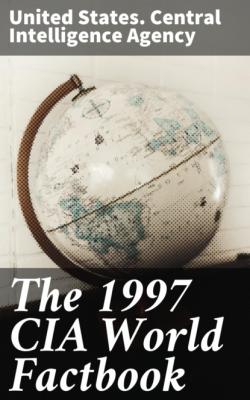The 1997 CIA World Factbook. United States. Central Intelligence Agency
Чтение книги онлайн.
Читать онлайн книгу The 1997 CIA World Factbook - United States. Central Intelligence Agency страница 11
 for fuel and building materials); desertification
for fuel and building materials); desertification
Environment - international agreements: party to : Desertification, Endangered Species, Environmental Modification, Marine Dumping, Nuclear Test Ban signed, but not ratified: Biodiversity, Climate Change, Hazardous Wastes, Law of the Sea, Marine Life Conservation
Geography - note: landlocked
@Afghanistan:People
Population: 23,738,085 (July 1997 est.)
Age structure: 0–14 years: 43% (male 5,201,585; female 5,003,503) 15–64 years: 54% (male 6,680,687; female 6,208,463) 65 years and over : 3% (male 341,301; female 302,546) (July 1997 est.)
Population growth rate: 4.48% (1997 est.) note: this rate reflects the continued return of refugees
Birth rate: 42.72 births/1,000 population (1997 est.)
Death rate: 17.78 deaths/1,000 population (1997 est.)
Net migration rate: 19.9 migrant(s)/1,000 population (1997 est.)
Sex ratio: at birth: 1.05 male(s)/female under 15 years : 1.04 male(s)/female 15–64 years: 1.08 male(s)/female 65 years and over: 1.13 male(s)/female total population: 1.06 male(s)/female (1997 est.)
Infant mortality rate: 146.7 deaths/1,000 live births (1997 est.)
Life expectancy at birth: total population : 46.34 years male: 46.89 years female: 45.76 years (1997 est.)
Total fertility rate: 6.07 children born/woman (1997 est.)
Nationality: noun: Afghan(s) adjective: Afghan
Ethnic groups: Pashtun 38%, Tajik 25%, Uzbek 6%, Hazara 19%, minor ethnic groups (Aimaks, Turkmen, Baloch, and others)
Religions: Sunni Muslim 84%, Shi'a Muslim 15%, other 1%
Languages: Pashtu 35%, Afghan Persian (Dari) 50%, Turkic languages (primarily Uzbek and Turkmen) 11%, 30 minor languages (primarily Balochi and Pashai) 4%, much bilingualism
Literacy: definition: age 15 and over can read and write total population: 31.5% male : 47.2% female: 15% (1995 est.)
@Afghanistan:Government
Country name: conventional long form: Islamic State of Afghanistan conventional short form: Afghanistan local long form : Dowlat-e Eslami-ye Afghanestan local short form: Afghanestan former: Republic of Afghanistan
Data code: AF
Government type: transitional government
National capital: Kabul
Administrative divisions: 30 provinces (velayat, singular - velayat);
Badakhshan, Badghis, Baghlan, Balkh, Bamian, Farah, Faryab, Ghazni,
Ghowr, Helmand, Herat, Jowzjan, Kabol, Kandahar, Kapisa, Konar,
Kondoz, Laghman, Lowgar, Nangarhar, Nimruz, Oruzgan, Paktia, Paktika,
Parvan, Samangan, Sar-e Pol, Takhar, Vardak, Zabol
note : there may be two new provinces of Nurestan (Nuristan) and
Khowst
Independence: 19 August 1919 (from UK control over Afghan foreign affairs)
National holiday: Victory of the Muslim Nation, 28 April; Remembrance
Day for Martyrs and Disabled, 4 May; Independence Day, 19 August
Constitution: none
Legal system: a new legal system has not been adopted but all factions tacitly agree they will follow Islamic law (Shari'a)
Suffrage: undetermined; previously males 15–50 years of age
Executive branch: on 27 September 1996, the ruling members of the Afghan Government were displaced by members of the Islamic Taliban movement; the Islamic State of Afghanistan has no functioning government at this time, and the country remains divided among fighting factions note: the Taliban have declared themselves the legitimate government of Afghanistan; the UN has deferred a decision on credentials and the Organization of the Islamic Conference has left the Afghan seat vacant until the question of legitimacy can be resolved through negotiations among the warring factions; the country is essentially divided along ethnic lines; the Taliban controls the capital of Kabul and approximately two-thirds of the country including the predominately ethnic Pashtun areas in southern Afghanistan; opposing factions have their stonghold in the ethnically diverse north - General DOSTAM's National Islamic Movement controls several northcentral provinces and Commander MASOOD controls the ethnic Tajik majority areas of the northeast
Legislative branch: non-functioning as of June 1993
Judicial branch: non-functioning as of March 1995, although there are local Shari'a (Islamic law) courts throughout the country
Political parties and leaders: Taliban (Religious Students Movement),
Mohammad OMAR; Supreme Defense Council of Afghanistan [comprised of
Jumbesh-i-Melli Islami (National Islamic Movement), Abdul Rashid
DOSTAM; Jamiat-i-Islami (Islamic Society), Burhanuddin RABBANI and
Ahmad Shah MASOOD; and Hizbi Wahdat-Khalili faction (Islamic Unity
Party), Abdul Karim KHALILI]; other smaller parties are Hizbi
Islami-Gulbuddin (Islamic Party), Gulbuddin HIKMATYAR faction; Hizbi
Islami-Khalis (Islamic Party), Yunis KHALIS faction; Ittihad-i-Islami
Barai Azadi Afghanistan (Islamic Union for the Liberation of
Afghanistan), Abdul Rasul SAYYAF; Harakat-Inqilab-i-Islami (Islamic
Revolutionary Movement), Mohammad Nabi MOHAMMADI;
Jabha-i-Najat-i-Milli Afghanistan (Afghanistan National Liberation
Front), Sibghatullah MOJADDEDI; Mahaz-i-Milli-Islami (National Islamic
Front), Sayed Ahamad GAILANI; Hizbi Wahdat-Akbari faction (Islamic
Unity Party), Mohammad Akbar AKBARI; Harakat-i-Islami (Islamic
Movement), Mohammed Asif MOHSENI
Political pressure groups and leaders: tribal elders represent
traditional Pashtun leadership; Afghan refugees in Pakistan,
Australia, US, and elsewhere have organized politically; Peshawar,
Pakistan-based groups such as the Coordination Council for National
Unity and Understanding in Afghanistan (CUNUA), Ishaq GAILANI; Writers
Union of Free Afghanistan (WUFA), A. Rasul AMIN; Mellat (Social
Democratic Party), leader NA
International